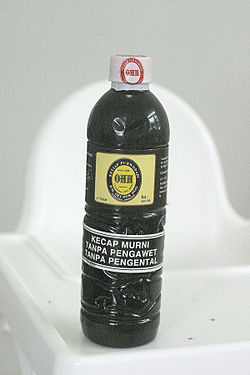 A bottle of Indonesian kecap manis | |
| Alternative names | Kecap manis |
|---|---|
| Type | Cooking sauce and condiment |
| Place of origin | Indonesia |
| Region or state | Java |
| Created by | Indonesians |
| Main ingredients | Fermented soy sweetened with palm sugar molasses |
| Variations | Soy sauce, mild sweet soy sauce |
Sweet soy sauce (Indonesian : kecap manis) is a sweetened aromatic soy sauce, originating in Indonesia, which has a darker color, a viscous syrupy consistency, and a molasses-like flavor due to the generous addition of palm sugar or jaggery. [1] Kecap manis is widely used with satay. It is similar to, though finer in flavor than, Chinese Tianmian sauce (tianmianjiang). [1] It is by far the most popular type of soy sauce employed in Indonesian cuisine and accounts for an estimated 90 percent of the nation's total soy sauce production. [2]






